
European Parliament – Paul-Henri SPAAK Building
Competition results

1st Prize
JDS Architects (Denmark) Coldefy (France) | NL Architects (Netherlands) | Carlo Ratti Associati (Italy) | ENSAMBLE STUDIO (Spain) | UTIL cvba (Belgium) | Ramboll (Denmark)

2nd Prize
JABORNEGG & PALFFY Generalplaner ZT GmbH (Austria) KUEHN MALVEZZI (Germany) | AXIS Ingenieurleistungen ZT GmbH (Austria)

3rd Prize
MOREAU KUSUNOKI (France) Dethier Architectures (Belgium) | sbp france (France) | ME Engineers Ltd (United Kingdom)

4th Prize
BELVEDERE ARCHITECTURE (France) Ove Arup & Partners International Ltd (United Kingdom)

5th Prize
A2M (Belgium) VK ENGINEERING (Belgium) | C.F. Møller Architects (Denmark)
Theme and objectives
Urban integration and links: the best planning solutions for the Paul-Henri SPAAK building and its surrounding area.
Architectural identity: a paradigm of architecture and strong visual identity for the building and the Chamber. This design had to support the architectural quality of the city and resonate with the European citizens as a representation of the power of their voice.
Cultural hub: a building that engages in dialogue with citizens and the city, a welcome centre for visitors and a focus of culture and debates for city residents.
Flexible use: a building that offers flexible spaces and must be able to adapt easily to the European Parliament’s development over time. The project must take into account the relationship between functions and between the building’s different users.
Sustainability: a positive example of sustainable and regenerative building.
Jury Members
General jurors:
- Rainer Wieland, Vice-President of the European Parliament, Germany
- Pedro Silva Pereira, Vice-President of the European Parliament, Portugal
- Rudy Vervoort, Minister-President of the Brussels-Capital Region, Belgium
- Bety Waknine, Head of the Brussels Planning and Heritage Regional Public Service, Belgium
Architectural jurors:
- Prof. Marilyne Andersen, Physicist and Environmental specialist, Lausanne, Switzerland
- Kristiaan Borret, Urban planner, Government Architect of the Brussels-Capital Region, Belgium
- Manuelle Gautrand, Architect, France
- Dorte Mandrup, Architect, Denmark (UIA representative )
- Carme Pigem, Architect, Spain
- Kazuyo Sejima, Architect, Japan
- Dimitri Tenezakis, Architect, Head of Luxembourg and Strasbourg Major Construction Projects Unit – DG INLO – European Parliament, Greece
Alternate general jurors:
- Heidi Hautala, Vice-President of the European Parliament, Finland
- Gilles Boyer, Quaestor of the European Parliament, France
- Alain Hutchinson, Brussels Commissioner for Europe and International Organisations, Belgium
- Thibaut Jossart, Director at the Brussels Planning and Heritage Regional Public Service, Belgium
Alternate architectural jurors:
- Romain Poulles, Engineer, Luxembourg
- Anna Przybyl, Architect, acting head of the Building Projects Unit in Strasbourg, – DG INLO – European Parliament, Poland
- Prof. Volker Staab, Architect, Germany
- Lisa de Visscher, Architect, Editor in chief of A+ magazine, Belgium (UIA representative)
Eligibility
Individuals eligible to participate were, on the day of the announcement of the competition and pursuant to the legal provisions of their country of residence, entitled to use the occupational title “Architect” according and work independently. Individuals from countries where the occupational title “Architect” is not subject to statutory regulations were eligible, provided that they hold a degree or submit any other evidence of formal qualification that was recognised in the EU under 2013/55/EU (EU Directive on the recognition of professional qualifications or prove of practice).